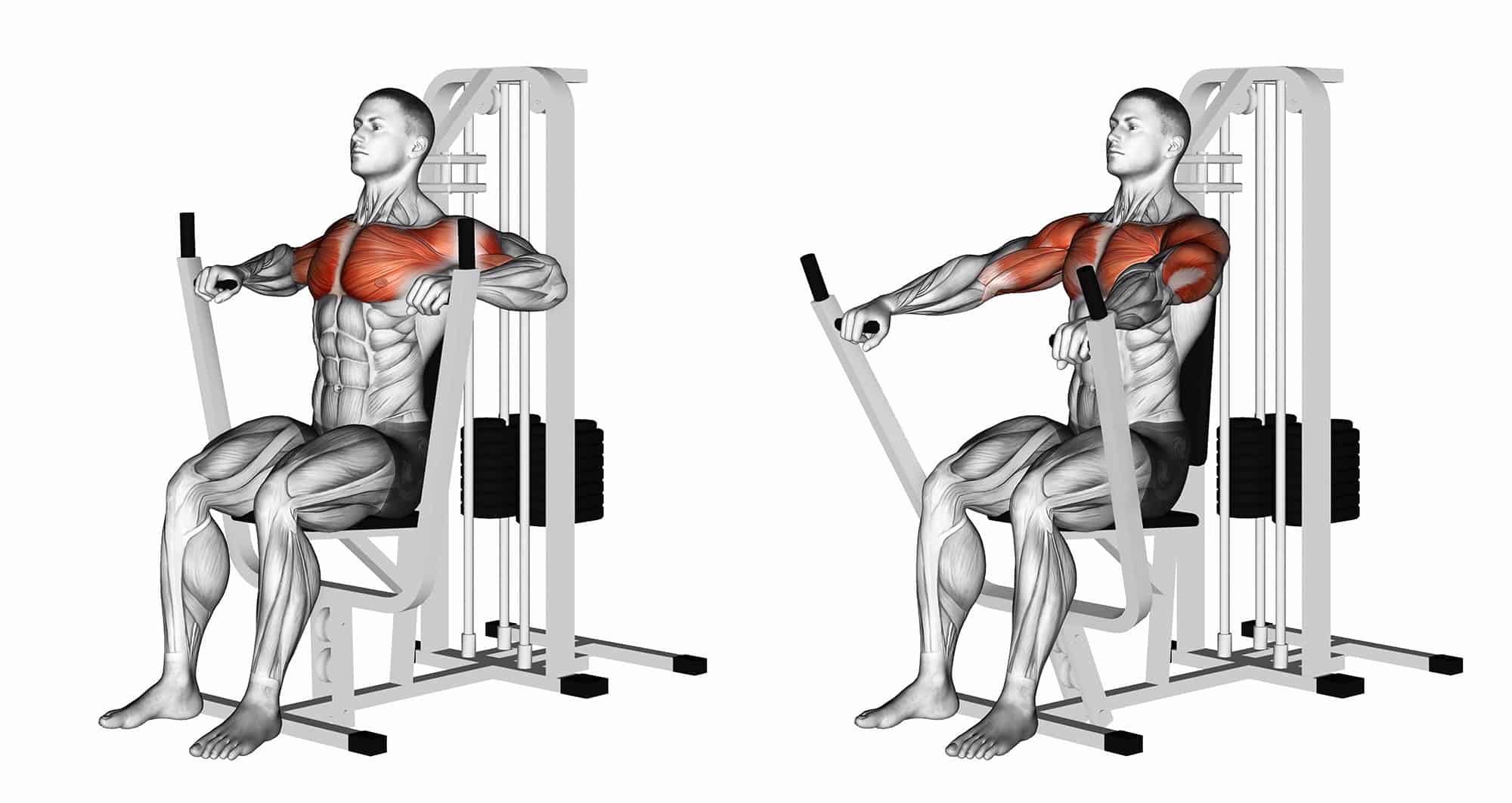There are many exercises out there that can give you that superhero look you’ve always wanted. We all want to look like Wolverine at some point in our lives (minus the claws, I guess).
Among many exercises (and there are a lot of them), I have looked hard and thorough in order to give you the rundown of the best chest exercises out there.
To know what exercises to do if you want great results in your lower chest, we will go through the basics and learn a bit about the human physique.
Lower chest is not a unified field of things that can be improved and developed. Many exercises will develop something on the lower chest but may not be as effective when it comes to the upper part.
There are many muscles (latin musculus) in your body, each having a different function.
Some of them are responsible for giving you the needed force, some of them have an impact on movement of internal organs or are involved in maintaining/changing posture.
In order to achieve the best results, it would be wise to acquaint yourself with each muscle group activated in an exercise. We are going to do just that with chest muscles in the next section of this article.
Table of Contents
Pecs
Every muscle in your body has fibers and is there to help you lift weights, move around or get things done with more flexibility. Fibers consist of muscle cells, each working in synchronicity when you push stuff or when you are doing exercise.
Pecs or pectoral musculus are located in the chest area of your body and are a group of musculus that connect the chest with bones of the upper arm and shoulder.
Pectoral musculus include pectoralis major and minor, subclavius muscle, serratus anterior and intercostal musculus [1].
Pectoralis major is the muscle located beneath the breast. Its function is to provide the flexibility and rotation of your arm’s long bone.
Pectoralis minor is located beneath the pectoralis major and its role is to provide the stability of your shoulders, i.e., the large bone of the shoulder called the scapula.
There are many exercises you can try in order to activate lower chest, upper chest or chest musculus in general. Push-ups are probably the most famous one.
Lower Chest Musculus
When you start with a chest exercise, chances are that all of the musculus in the chest area are activated to some degree. When working on your lower chest by doing lower chest exercises, you are producing that appealing look seen on many athletes.
Many lower chest workouts can help you build stunning pectorals. While doing a workout, it isn’t just the look that you are improving, but the overall movement of your arms and body is improved as well.
Developing powerful lower pecs will improve your shoulders flexibility in rotational and many different types of movements, keeping them stabilised and providing them with the right amount of power.
How Do You Fix Lower Chest Imbalance?
Chest imbalance could be an inborn flaw or the result of some condition for which you have to seek medical attention. But, in most cases, using one side of your chest more than the other when doing workouts, will be the cause of chest imbalance.
To fix this problem, in most cases, you need to work on your chest top, which means developing major pectorals and pectoralis minor.
There are several exercises that can target the lower and upper body when it comes to those chest muscle groups. You can use dumbbells, do pushups and pullups and even perform yoga (yes, at some point in our lives all of us start doing yoga)
Dumbbells are great because you can adjust the intensity and position of your arms to activate the desired area and get the best results.
Some exercises are chest press, decline or incline bench press and lying or standing chest fly [2]. You can lift them or push them from your body and target the lower chest.
Dips
This is, in my opinion, the best lower chest workout among many exercises out there. Chest workout, where you lower yourself and then push the body in spite of gravity is nothing less than an art form.
For a dip training, set of parallel bars (if you are not a gym member, go outside, find a park with exercise scenery and you will most certainly find a couple of bars)
This exercise will activate almost every muscle in your back, shoulders, arms and of course your lower chest with every dip. To target the lower chest, lean forward on the dip and place your arms above your feet with hands firmly on the bar [3].
Doing reps means pushing yourself from the bar with hands. Make sure to breathe properly, i.e. inhale while lowering your body and exhale when lifting yourself above the bar.
Watch out for the elbows when bending the arms and keep your spine straight through your training for the best results.
Always rest between sets and don’t push yourself in the beginning before. Wait until you’ve started to develop the strength and stronger arms needed for more strenuous exercise.
You can do many variations of this workout depending on the angle of the dips and position of your body. After the dip, you can push yourself and stay for a bit which can produce more strength and stamina in your triceps.
This way, you will induce more pressure on the lower chest and increase the strength for the future exercise routines.
One way to improve the intensity of the dips is to include additional weights that will be attached to your body. You can use body weights but make sure you use the right amount.
This way, not only when you dip, but also when you push yourself from the bar, the pressure will become stronger. This is a similar effect when you transit from decline to incline press.
If your dips are becoming too hard for you, it is wise to decrease your weight or lose them altogether.
Always count the number of dips in order to have the right number of repetitions. Doing exercises means always improving your body and health, and if you don’t pay attention you could end up doing the same number of repetitions for a long period of time.
Even though you need to push yourself to achieve better results over time, never go against your body and health. If you feel ill or have some lower chest pain, always seek medical advice.
Dumbbell Decline And Incline Bench Press
Doing this exercise is great for your muscle fibers and is perfect to target pectorals in the higher body area. Depending on the position and the angle, you can work on your lower chest muscle area but also on your shoulders, triceps and lower chest in general.
Decline bench press workout is great for developing each chest muscle in the upper body and will help you build powerful pectorals if performed accurately [4].
To start, go into the lying position, preferable on the decline bench, with a dumbbell in each hand and your head inline with the spine. Put your hands next down, next to your body.
To do a rep, push the weight, with elbows slightly bent and never above your shoulders, and reach the position in front of your lower chest.
Depending on the shape you are in, to build strong pectorals, begin with the 10 repetitions per set and increase the number as you go forward..
If you want to target the lower chest, decline bench press could be varied to some degree to allow your lower muscle fibers reinforcement with weights lifting training in each hand.
Each arm is lifting the separate weight which means you need to get them in sinc, something totally different when using a single bar. That is why, this workout is also great for stabilizing and correcting the uneven parts of your body and lower chest.
Among many exercises, incline bench press is also a great workout when it comes to correction of muscle imbalance.
This exercise, aside for its effects on the higher area, will be the one routine you will always return to if your goal is to develop the lower area and lower chest in general as well.
Cable Crossover
For this exercise you will need a cable machine, which means this lower chest workout needs to be done in a gym.
This workout is great for lower chest and can produce best results if done properly.
Before doing a cable crossover, you need to adjust the position of the pulleys. If your goal is to develop the upper chest, then place them in a higher position, but if you seek to work on your upper chest, then lower them down.
To begin the training, put each arm on the pulley on the top of the handle. Slowly bring the bar in the position above your head.
Stand straight with one foot in the starting position and one in front of your body. For the right angle, put both hands on the top of the cable holder.
After a few seconds, pull the weights of the cable to your body, just to get them close, and make sure to squeeze the pectorals in order to build them.
Your musculus will be stretched after each repetition so make sure you are doing this training routine with the right angle, not bending the knees too much or lifting each arm too much above the head.
The Bottom Line
Knowing which area you are working on is helpful in deciding what kind of exercise is best for you.
Always watch on the angle of your body and the position of your head for best results. Push yourself to achieve better results in your chest workout over time but not to the extent of jeopardising your health.
For the lower chest, you should be doing dips, pulling cable or lifting small weights. These are the most effective chest workout routines out there.
References
- https://www.ncbi.nlm.nih.gov/books/NBK545241/
- https://www.healthline.com/health/uneven-chest
- https://www.healthline.com/health/fitness-exercise/lower-chest-exercises
- https://www.ncbi.nlm.nih.gov/pmc/articles/PMC5504579/






